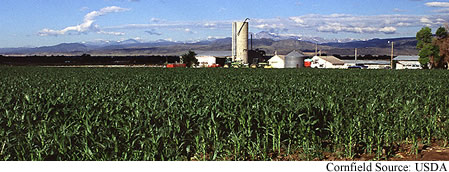 |
||||||||||||
![]()

Millions of acres of insect-resistant crops, including cotton, corn and potatoes are planted in the United States each year. These crops contain a gene from the bacterium Bacillus thuringiensis. The plants produce insecticidal proteins to provide an effective, environmentally safe pest control.
As a consumer of these crops in the United States, you may have concerns and questions regarding these crops.
Here are some short answers to some FAQs. If you wish to learn more, click on the links on the left to explore Bt.
Bt stands for the naturally occurring bacterium Bacillus thuringiensis. Bt lives in the soil and is found all over the world. Some types of Bt produce a protein crystal that is toxic to insects. These protein crystals have been used in organic farming for over 50 years to control insects. The genes producing these proteins are now engineered so that plants can make the protein in their cells.
Learn more about Bt
What is a protein crystal
Go back to top
Bt has been found to be safe to all mammals, birds, and fish. Bt is very selective and is only toxic to specific insects.
Resources:
EPA
Bacillus thuringiensis: Biology, Ecology and Safety
Glare, T.R., O'Callaghan, M. (2000) ISBN 0-471-49630-8
Are Bt proteins safe for the environment?
Bt is safer to the environment than synthetic pesticides. Unlike synthetic pesticides, Bt is selective and will only kill specific insects. This may help beneficial insects because Bt does not target them.
Bt transgenic crops has been shown to reduce the amount of insecticides in runoffs.
Reference:
USDA
Bacillus thuringiensis: Biology, Ecology and Safety
Glare, T.R., O'Callaghan, M. (2000) ISBN 0-471-49630-8
How is use of Bt proteins regulated?
The EPA in the United States regulates the use of Bt crops. Rules and regulations have been set for farmers that want to use Bt crops.
Bt is used in sprays by organic
farmers.
Bt is used in transgenic crops all
over the world.
Bt is used in sprayings over urban areas (vector
control) to control mosquitoes and other disease-carrying insects.
Does Bt harm monarch butterflies?
No.
Resources:
EPA
USDA Research Q&A:
Bt Corn and Monarch Butterflies
USDA
Bt Corn Not a Threat to Monarchs
Bt is used to help reduce environmental damages by acting as a substitute to synthetic pesticides. It can also help increase crop gains.
Aggregates of proteins made byt Bt that builds up to form a crystal.
What are some Bt protein concerns?
Insect resistance is one of the biggest concerns with Bt. Up till now, resistance in the field have been very rare. But laboratory studies have shown that insects are capable of developing resistance. It is only a matter of time when insects in the field develop resistance to Bt.
Learn more about resistance
Go back to top
With the increased use of Bt, there is a likelihood that insects will develop resistance to Bt. Scientists all over the world are working to understand Bt and resistance to prevent this from happening.